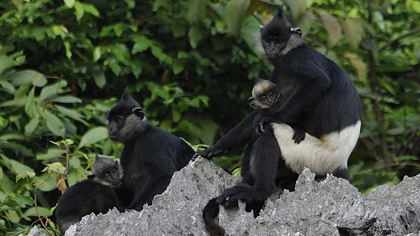World's second largest population of Delacour's langur discovered in Vietnam
The world’s second largest population of Delacour’s langurs, a critically endangered primate indigenous to Vietnam, has recently been discovered in the forests of northern Vietnam, giving hope to the conservation of this rare species.
 |
The population consists of seven troops with as many as 40 individual primates, according to Trinh Dinh Hoang from Fauna & Flora International (FFI) Vietnam, the NGO that discovered the langurs. He also added that the largest population of the primate is also in Vietnam.
The exact location of the discovery has been kept secret to prevent poaching.
"This discovery is good news – both for the species and for the people of Vietnam, particularly because we have also identified a number of infants and juveniles among the groups," Hoang said. "This means that they are breeding and, if we can protect them, they should be able to thrive in this habitat once again."
Measures are needed to help protect the precious primate from extinction like hunting and stone mining which destroys their natural habitat, said Benjamin Rawson, country director of FFI Vietnam.
At a recent conference in Chicago, Country Director Benjamin Rawson said “We've notified the Vietnamese authorities of our findings and recommendations, and we will continue to work alongside officials and local communities to ensure the Delacour’s langur doesn’t become this century’s first primate extinction”.
The Delacour’s langur is a primate indigenous to Vietnam, first discovered by and named after Jean Théodore Delacour in 1930.
In the early 1990s, a survey recorded 281-317 Delacour’s langur belonging to 19 populations in an area of about 5,000 square kilometers in northern Vietnam. More recent surveys indicate that populations and numbers have dwindled. In the last decade, nine subpopulations have been wiped out.
(Source: NDO)
 về đầu trang
về đầu trang




